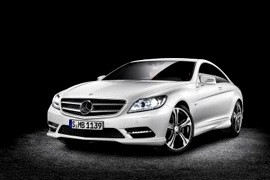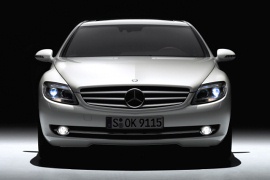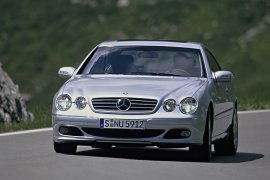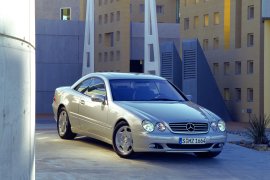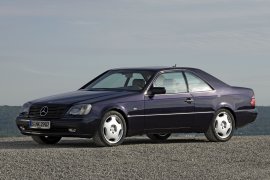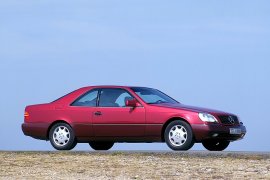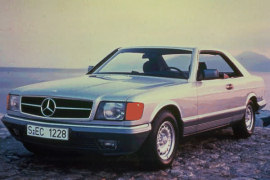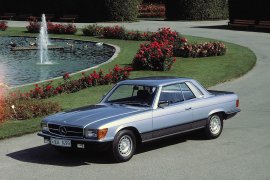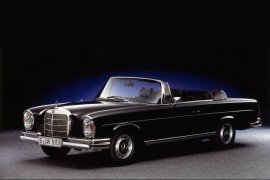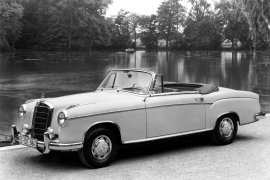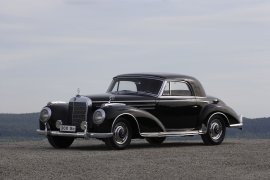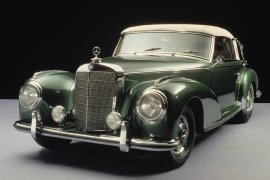MERCEDES BENZ CL-Klasse and predecessors Models/Series Timeline, Specifications & Photos
First production year: 1952
Engines: Gasoline
Body style: Coupé (two-door)
Mercedes-Benz introduced a facelifted version of its CL-Class at the 2010 Goodwood Festival of Speed, raising the bar for high-performance, luxurious coupes.
The German automaker launched the third generation of the CL in 2006 at the Paris Motor Show as a personal luxury coupe. It was more than a GT in terms of luxury but didn't lack in the performance department either. Yet, it wasn't exactly a sports car. With the updated version, the automaker enhanced the car's look and improved the engine lineup to comply with the Euro 5 emission standards.
Unlike its more potent AMG versions, the CL 500 and 600 sported a different front fascia. Make no mistake, it was still luxurious and opulent, but it didn't have the same aggressive stance. Instead, it boasted new bi-xenon headlights. In addition, the front bumper featured LED daytime running lights. Furthermore, the carmaker offered an AMG package with an A-shaped grille in the front lower bumper instead of the standard trapezoidal-shaped one.
Apart from the luxurious interior, the car received more safety systems, such as the Active Lane Keeping Assist and crosswind assist functions. In addition, the automaker added a new COMMAND infotainment system fitted with a unique display that allowed the driver to see the navigation and, at the same time, its passenger to watch a movie on the same screen.
But the most significant changes were made under the hood. The naturally aspirated engines from the 2006 model were replaced by smaller, twin-turbo powerplants. Thus, the power output was increased for both 500 and 600 models, respectively. The CL 500 was available with an all-wheel drive system named 4Matic. Also, in the technical department, the CL boasted an adaptive suspension for specific versions and markets. All vehicles were fitted with a seven-speed automatic gearbox as standard.
The 2006 Mercedes-Benz CL continued the great line of Gran Tourer vehicles from the German premium car-maker. It was offered only with gasoline engines.
The 2006 CL was a bit longer than its predecessor, but it had a lot more to offer. From the interior room and bigger trunk to the advanced suspension and more powerful engines, everything was changed. It was the result of six years of development.
A long hood, curved greenhouse, and no B-pillars were some of the features of the Mercedes-Benz CL. It kept that from its predecessor and enhanced them in every way. With a better aerodynamic that led to lower wind noise and enhanced look, it was on top of its class. With a side sculptured line across the entire body, and rear flared arches, it inspired both elegance and sportiness.
Inside, the luxury features were carried over from the S-Class inventory. Large, comfortable front seats were installed. To enhance comfort and clean-up the center console between the front passengers, the CL featured a steering-column mounted gearshift for the automatic transmission. To enhance the ride quality, a panoramic glass roof was fitted as standard.
For more comfort, the car featured the Active Body Control system, that controlled the car's rigidity, or better cornering speed when it was set in the sport mode. For the engine compartment, the CL featured four V8 engines and two V12, with the AMG versions included. All vehicles featured automatic transmission.
After three years on the market, the CL lineup from the German premium automaker Mercedes-Benz went through a facelift that improved it in more areas.
By 2002 standards, the refreshed version of the CL was more than people could ever dream of having in their cars. Features such as fiber-optics sound systems, bi-Xenon headlights, and adaptive suspensions were things only envisioned on some concept cars from that era. And yet, the three-pointed-star brand brought them on the market and offered them to the public, for a hefty fee, of course.
With its quad-headlights front fascia and the three-slat grille, the CL was both an elegant and sporty vehicle. Depending on the version, the lower apron featured a smile-shaped center air intake flanked by two side scoops or an angry-looking one for the version fitted with the AMG package. From its profile, the CL was sleek, with a raked windshield and a short roof. The arched window line ran uninterrupted between the front and rear pillars of the greenhouse. Moreover, the C-pillar was retractable and lowered together with the rear side windows. By European standards, this was a faux-cabriolet vehicle, while other nations called it a hard-top. At the back, the revised taillights featured two clear horizontal lines for the reversing lights on each side.
Inside, the carmaker offered a leather-wrapped interior fitted as standard for the entire range and a new COMMAND infotainment unit placed on the center stack. The same sound system was available on the S-Class and the E-Class from the same era. But, unlike its siblings, the CL was offered an unusual option: a start-engine button mounted on the gear knob.
Under the hood, the carmaker installed a choice of two engines: a 5.0-liter V8 and a 6.0-liter V12, both being shared with the brand's flagship, the S-Class. The only available transmission was the five-speed (5G-Tronic) gearbox that sent the power to the rear wheels. A CL55-AMG was also available.
Even though the second generation of the CL broke covers at the 1999 Paris Motor Show and stayed on the market for just about six years, it made a difference in the personal luxury coupes segment.
The second generation of the CL-Class was made to provide comfortable, fast rides on long distances. That's why Mercedes-Benz made them only with V8 and V12 engines, either naturally aspirated or supercharged. The standard transmission for it was a five-speed automatic, known for its reliability and sturdiness.
But there is one thing that was hard to beat by other automakers, and that was the design. Its sheer size and the four-headlamps system looked just great. Moreover, the B-post was retractable along with the rear side windows, thus creating the image of a fake cabriolet (or hard top). At the back, the deck was short compared to the rest of the car, but its size wasn't that small. In addition, the taillights followed a similar triangular design seen on the C-Class, E-Class, and S-Class. The overall look of the vehicle was sleek and had a 0.30 aerodynamic coefficient, which was excellent for those times.
Inside, the leather-wrapped cabin provided ample room for all four occupants. The driver and the side passenger had easy access to power-adjustable seat controls that were mounted on the door cards. On the center stack, the premium sound system was standard, but the navi was not. In the back, the automaker installed two individual seats separated by a center console.
Even though Mercedes-Benz didn't make any money by selling this car, it still built it for about six years and installed big, powerful gasoline engines underneath its hood.
In its pursuit to offer a coupe version for its flagship model, the S-Class, Mercedes-Benz struggled to find a proper name and, in 1996, it came up with the CL designation.
The 1996 CL was more of a facelift for the SEC model, that was built since 1992. Both the SEC and the CL shared the same modified platform from the W140 S-Class sedan. It was built more like a grand tourer, with four rear seats and comfortable suspension.
The CL didn't look like a sports car. It was tall, wide, and with a big front fascia. It borrowed some styling principles from the S-Class. On the side, the frameless windows and the rear windows could roll down and, without a B-pillar, the car offered the image of a faux-cabriolet (fake cabriolet).
Inside, it was built as a luxury vehicle, with a big and tall dashboard, a straight center stack and more features carried over from the S-Class. Its instrument cluster featured five round dials with a total of seven gauges for various information. The leather upholstery and the wood grain were standard. As a novelty for those times was the parktronic system, which added parking sensors and digital displays for it.
For the engine bay, the car-maker installed only V8 and V12 gasoline units mated to a standard 5-speed automatic gearbox. For safety systems, the CL was fitted with a traction control system.
Mercedes-Benz introduced a two-door version of its flagship model, the mighty S-Class, thus continuing its tradition of producing personal luxury coupes for its customers.
Unlike its main rival, BMW, who focused on a sporty image with its 8 Series, the CL-Class (C140) was built to provide comfort and luxury. Its look was far from slim or aerodynamic. Instead, it was bulky and demanding, more focused on customers who didn't want to reach the top speed of the vehicle on a daily basis. They just wanted to be spoiled and pampered on their way to the office or vacation lodge. Thus, around 20,000 units of this majestic, luxurious coupe were built in its seven-year lifespan.
Even though it was the two-door version of the S-Class, it didn't share any body panel with its four-door sibling. Its body-colored bumpers, black grille, and swept-back headlights looked futuristic for those times. From its profile, the S-Class Coupe (codenamed C140) featured an ascending beltline that stretched beyond the cabin onto the tall rear deck. The B-post was retractable. Thus, with all four windows rolled down, it looked like a hard-top coupe or a fake cabriolet (by European standards).
Inside, the leather-wrapped cabin featured comfortable bucket seats at the front and a benchseat for two in the back. The dashboard featured an instrument cluster with an angular design, where the speedometer took center stage. On the sloped center stack, the automaker installed the HVAC and audio controls, while the center console hosted the gear selector.
Since the car was meant to be both a companion for exquisite events and long travels, it was fitted with a choice of two V8s and a V12 engine, all paired with a five-speed automatic.
Mercedes-Benz launched the 380 SEC and 500 SEC at the 1981 Frankfurt Motor Show. It was the successor of the previous SLS range, and it was based on the same platform with the S-Class W126.
With a high-demand for personal luxury coupes, Mercedes-Benz offered a new generation of S-Class coupe in the form of the SEC models, in 1981. Its success was so big that the car-maker decided to make it until 1992. The SEC was facelifted in 1984.
From the outside, the sleek coupe line was inspired by the four-door sedan version, but it didn't carry too many body panels from that. The front fascia was similar, but not the same. A different grille design and similar headlights were installed. The raked A-pillars and the long front doors were a stylish mark for the SEC generation. The B-pillar was removed and with all four windows rolled down, it looked like a faux-cabriolet.
Inside, the car offered seating for four. It was the first car to feature a seat belt presenter. When the doors were closed, and the engine started, the presenters extended the shoulder anchor to the front passengers, to ease the reach and grab of seat belts. The standard version featured cloth seats, while in the upper trim level the leather upholstery and the wood grain on the dash, center console, and stack were standard fit.
In the U.S., the SEC was available with the 3.8-liter V8 engine only, due to the CAFE regulations. Some gray imports allowed the introduction of some 500 SEC until the law was changed and the potential customers couldn't buy them anymore. The standard transmission for the entire range was a 4-speed automatic. In 1985, the 3.8-liter unit was replaced by the larger 4.2-liter and the 5.6-liter V8 was introduced.
MERCEDES BENZ S-Klasse Coupe (C126) 380 SEC 4AT (207 HP)
MERCEDES BENZ S-Klasse Coupe (C126) 420 SEC 4AT (204 HP)
MERCEDES BENZ S-Klasse Coupe (C126) 420 SEC 4AT (218 HP)
MERCEDES BENZ S-Klasse Coupe (C126) 420 SEC 4AT (224 HP)
MERCEDES BENZ S-Klasse Coupe (C126) 420 SEC 4AT (231 HP)
MERCEDES BENZ S-Klasse Coupe (C126) 500 SEC (265 HP)
MERCEDES BENZ S-Klasse Coupe (C126) 500 SEC 4AT (223 HP)
MERCEDES BENZ S-Klasse Coupe (C126) 500 SEC 4AT (245 HP)
MERCEDES BENZ S-Klasse Coupe (C126) 500 SEC 4AT (252 HP)
MERCEDES BENZ S-Klasse Coupe (C126) 560 SEC 4AT (245 HP)
Mercedes-Benz introduced the SLC at the 1971 Paris Motor Show as a fixed-roof version for the SL Roadster R107.
While the carmaker already offered a removable hardtop for the SL roadster, the customers demanded a two-door version. Despite having a closed-body construction, it wasn't stiffer than its roadster brother, but it was a personal luxury coupe that carried over the legacy of the SL300 "Gullwing" model.
Unlike its open-top sibling, it featured a longer wheelbase. At the front, it featured the same front fascia with a black grille that sported the big three-pointed-star badge and a chromed horizontal slat. Its corner-mounted turn-signals were raised on the rear side. Mercedes-Benz designers hid the extended cabin by adding a fixed glass panel behind the rear side windows. By those time standards, it was a fake-cabriolet.
Mercedes-Benz made the SLC longer than the roadster so that it could fit a bench in the rear. Thus, the two-seat roadster was able to host four occupants inside. Yet, there was limited legroom in the back, if any, depending on the driver's height. The list of standard features was long and included air-conditioning and a stereo.
The SLC received a 3.5-liter V-8 engine at the launch, with a 4.5-liter joining the range in 1973. After the oil crisis from the same year, the carmaker rushed and installed a 2.8-liter, fuel-injected engine. It was an intelligent decision since its fuel efficiency was far better than the carburetor-type 3.5-liter unit. By the late '70s, the SLC received a 5.0-liter V-8 paired with a standard automatic transmission. It was the first V-8 car to win a World Rally Championship event.
After the Mercedes-Benz 600 Laundaulet built in one unit for former racing driver Count von Berckheim in 1967, the 600 Coupe was the rarest W100 ever made.
The 600 Coupe was built in only two original units and none of them were sold. They were offered as gifts for the former chief designer Rudolf Uhlenhaut and the other for Fritz Nallinger, former head of research and development department of the Mercedes. These were the only two vehicles built in 1965. These cars had a shorter wheelbase 22 cm (8.6“) than the SWB sedan. There was a custom-built third vehicle, which was transformed from a short-wheelbase W100 into a coupe.
The design of the car was identical to the four-door version up until the A-pillars. A longer front door was needed to ease the access to the rear seats. The rear side windows were custom made but the rear window was the same as for the rest of the W100.
Inside, the access was via the front doors and reclining front seats. Since both vehicles were built for special order, they were fitted with all the amenities that were available. The air-conditioning unit and the wood trims for the interior were part of the features.
Under the hood, the engineers installed the same 6.3-liter M100 engine from the rest of the W100 range. Other mechanical adjustments were needed, but the final result was considered as the first personal luxury coupe built by Mercedes-Benz after WWII.
Mercedes-Benz introduced a new luxurious coupe in 1961, thus replacing the W128, which was withdrawn from the production line in 1960.
Even though most customers used these luxurious coupes to travel with just two people onboard the vehicle, the German automaker considered that offering a four-seat car would be more attractive. And it was right! Thus, the vehicle could provide comfort and luxury for up to four adults. In addition, those who used the 220 SE for long jaunts could use the rear bench as additional storage.
The car's design resembled its four-door sibling, but unlike that, it featured smaller tailfins at the back of the vehicle, flanking the trunk's lid. Still, it shared the front fascia with that version and with the open-top variant as well. Like all luxurious vehicles from that era, the elegant coupe from Stuttgart was adorned with many chromed trims on the bumpers, door handles, and the radiator's grille.
Inside, the car featured leather and chromed all over the place. The luxurious interior was meant for rich people with high taste and big expectations. Its front bucket seats were designed for comfort, and the rear bench seat hosted a folding armrest.
Under the hood, the W111 Coupe featured a choice of engines with mechanical fuel injection built by Bosch. The rarest version was the 300 SE with a 3.0-liter inline-six engine with only 708 units produced.
In 1961, Mercedes-Benz showed an open-top version of the 220 SEb sedan coupe. It was the successor of the 128 convertible, a model that was no longer produced since 1960.
Unlike their predecessors, the W111 and the W112 were planned to be true four-seated vehicles. To get that, the car-maker used the same chassis from the sedan, with the same wheelbase. Unlike the sedan though, it didn't feature the same tailfins. The success of the car showed by the German car-maker, convinced the management that it will be a successful model. And it was.
The headlights and the radiator grille were the same as for the 220 SEb sedan with gasoline engines. On the sides, the longer doors were similar to the coupe versions but the rear was unlike the other two. While the four-door featured tailfins, the coupe had them lowered and the convertible didn't feature them.
Inside, the car featured leather and chromed all over the place. The luxurious interior was meant for rich people with high taste and big expectations. The car was fitted as standard with a 4-speed automatic transmission just to enhance the driving experience.
Under the hood, the W111 cabriolet featured a choice of engines with mechanical fuel injection built by Bosch. The rarest version was the 300 SE with a 3.0-liter inline-six engine with only 708 units produced. The top model featured the 3.5-liter V8 unit, which was produced in 1232 units.
Three months after the introduction of the launch of the W180 Convertible, Mercedes-Benz launched a fixed-roof version of it named Coupe.
Since it shared most of its parts with its sibling, the 220 S Coupe was based on the same shortened chassis as the 220 A Sedan version. Thus, the German automaker expanded its lineup and provided customers with an elegant vehicle built not just for long travels but also as a boulevard cruiser. It was not built for speed, and that was easy to notice just by taking a look at its specs. But its owners didn't seem to care too much about that.
Since the Pontoon was designed with a crumple zone at the front, the Coupe carried over all the elements of its open-top sibling. That included the one-piece chromed bumper at the front, which was a radical design for those times. Another safety measure was the introduction of the turn signals placed on top of the fenders, which made them more visible to fellow drivers. Like the rest of the vehicles from those times, it sported round headlights surrounded by chromed rims. From its profile, the curved lines of the bodywork continued on the greenhouse, which didn't feature side windows behind the doors. At the back, the integrated taillights in the rear quarter-panels, the wide and curved trunk lid, and the single-piece bumper were just a few details that showed the design change in the Mercedes-Benz philosophy.
Inside, the automaker installed a pair of bucket seats at the front and a bench for two in the back. Still, there was hardly any legroom left for those rear-seated passengers. But the automaker knew this and offered the option to fold down the rear bench, thus transforming it into a storage area.
Under the hood, there was an inline-six engine with two downdraught carburetors that produced 106 hp in 1957. A year later, a single-point injection (the injector was in the manifold) was available and increased the output to 115 hp.
The 1956 Mercedes-Benz 220 S and 220 SE Cabriolet are rare gems in automotive history. The German car-manufacturer built only 5731 of these, from which 1942 were the fuel-injected SE.
Just two months after the last 220 A Convertible roll-out from the factory in 1955 and a 220 Convertible based on Type 220 A sedan was shown at the Frankfurt Motor Show. It was built on a shortened chassis by 120 mm (4.7") when compared with the 220 S. But the vehicle shown was just a show and it didn't go into production.
The model series that went into production in 1956 but was based instead on the 220 S, the successor of the 220 A. The turn-signal placed on top of the front fenders, the integrated taillights in the rear quarter-panels, the wider hood, and the tall grille were just a few details that showed the design change in the Mercedes-Benz philosophy.
Under the hood, there was an inline-six engine with two downdraught carburetors that produced 106 hp in 1957. A year later, a single point injection (the injector was in the manifold) was available and increased the output to 115 hp. The engine featured a chain-driven overhead camshaft with two valves per cylinder.
In 1959, three completely redesigned 6-cylinder engines and a new "fintail" body were presented along with the new sedan versions. These engines were also installed in the 220 Cabriolet. The last carburetor engine was installed in the convertible in October 1959. The new injection system, along with higher camshafts and straight pipes increased the output to 120 hp.
In the early '50s, Europe was coming back from the debris left by WWII, and, despite anyone's beliefs, Mercedes-Benz introduced the stunning luxurious 300 Coupe at the 1951 Paris Motor Show.
After the war, Mercedes-Benz started to build vehicles mainly for commercial vehicles, taxi companies, police, and authorities. In late 1951, though, it launched the luxurious 300 lineup, followed by the Coupe version in the same year, with sales in 1952.
While the era of wide fenders and narrow engine compartments started to fade away, the German carmaker still relied on that design language when it made the 300 Coupe. When compared to pre-war vehicles, one big difference was that the round headlights were integrated into the fenders instead of placing them on separate struts. In addition, the tall, V-shaped grille sported chromed trims and surroundings that gave the car a commanding presence on the roads. From its sides, the fenders were extended onto the front door panels above the side steps. An additional chromed strip was stretched along with the bodywork toward the rear, enlarged above the wheels, quarter panels. At the back, the trunk featured a lid, and the spare wheel was placed inside.
The cabin was fit for two persons, and it was a true luxury coupe. Thanks to the gear selector mounted on the steering column, there was a free passage from left to right. Also, unlike many pre-war vehicles, the 300 Coupe featured the instrument panel in front of the driver, mounted on the wood-finished dashboard.
Under the hood, Mercedes-Benz installed its famous three-liter inline-six in two versions: a naturally aspirated and a supercharged one. Both were mated to a four-speed manual.
Mercedes-Benz tried to get back after WWII and still relied on some technologies developed before 1938, but it managed to bounce back.
In late 1951, the German automaker introduced the stunning luxurious 300 Coupe and the 300 Cabriolet A at the 1951 Paris Motor Show. These were the most expensive cars on the market and aimed high at those looking for luxury vehicles and had deep pockets for them.
While the era of wide fenders and narrow engine compartments started to fade away, the German carmaker still relied on that design language when it made the 300 Cabriolet. When compared to pre-war vehicles, one big difference was that the round headlights were integrated into the fenders instead of placing them on separate struts. In addition, the tall, V-shaped grille sported chromed trims and surroundings that gave the car a commanding presence on the roads. Its canvas top couldn't be concealed behind the cabin, but it didn't look bad either. After all, it was just like the other cars from the same segment. But just a bit more luxurious.
The cabin was fit for two persons, and it was a true luxury coupe. Thanks to the gear selector mounted on the steering column, there was a free passage from left to right. Also, unlike many pre-war vehicles, the 300 Coupe featured the instrument panel in front of the driver, mounted on the wood-finished dashboard.
Under the hood, Mercedes-Benz installed its famous three-liter inline-six in two versions: a naturally aspirated and a supercharged one. Both were mated to a four-speed manual.
